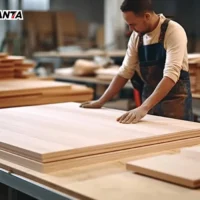Table of contents
What is Formply?
Formply is a phenolic film-coated plywood that is specifically manufactured for formwork applications in construction. It features a strong, high-quality plywood core bonded with a waterproof adhesive, ensuring durability and resistance to moisture. The “F” rating represents the stress grade of the plywood, with higher numbers indicating greater strength.
Formply is a high-strength plywood designed for concrete formwork and other heavy-duty construction applications. It is available in different grades, including F14 and F17, which indicate the plywood’s structural strength and load-bearing capacity. Understanding the differences between these two grades is essential for selecting the right material for your project.

Key Differences Between F14 and F17 Formply
Both F14 and F17 formply are commonly used in construction, but they differ in their load-bearing capacity, strength, and applications.
1. Load-Bearing Capacity and Strength
- F14 Formply:
- Has a lower structural strength compared to F17.
- Suitable for light to medium construction applications.
- Can support moderate concrete loads but may require additional bracing in large-scale projects.
- F17 Formply:
- Has a higher stress grade, meaning it can withstand greater loads and higher pressure.
- Used in heavy-duty formwork applications.
- Reduces the need for extra bracing, making it a cost-effective option for large projects.
2. Application Differences
- F14 Formply Applications:
- Residential and low-rise building formwork.
- Temporary structures, such as scaffolding and hoardings.
- General-purpose construction where extreme load capacity is not required.
- F17 Formply Applications:
- High-rise and commercial construction requiring strong formwork.
- Bridges, tunnels, and infrastructure projects.
- Heavily reinforced concrete structures where strength is critical.
3. Cost Comparison
- F14 Formply: Generally more affordable due to its lower stress rating. Ideal for budget-conscious projects where extreme load resistance is unnecessary.
- F17 Formply: Slightly more expensive but more durable and cost-effective in the long run, especially in large projects requiring high strength.
4. Reusability and Lifespan
- F14 Formply: Can be reused several times but may wear out faster under heavy loads.
- F17 Formply: More durable and longer-lasting, capable of being reused multiple times without losing its strength.
Which One Should You Choose?
- Choose F14 Formply if you need a cost-effective option for general construction or lightweight formwork.
- Opt for F17 Formply if your project involves heavy loads, reinforced concrete, or commercial-scale construction.
Conclusion
The primary difference between F14 and F17 formply lies in their strength and load-bearing capacity. While both are durable and moisture-resistant, F17 formply is the stronger and more robust choice for demanding construction projects. Selecting the right formply depends on project requirements, budget, and structural needs. Understanding these differences ensures efficiency, safety, and cost-effectiveness in construction.
Articles you may be interested in.





















